
Forgetting to check for brood when harvesting honey
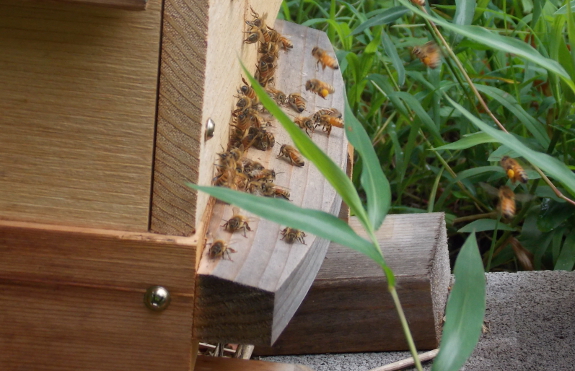
You'd think that
since we've had bees for over four years now, we would have
harvested a lot of honey. Unfortunately, since I'm
stubbornly refusing to use chemicals in the hives, it's been quite
a learning curve, and this is only the second year I've gone to
steal honey from the bees.
The first time around
was in 2010. Our bees had arrived as a package over a year
before, so in June I figured I could take any honey they had left
over from the winter. Despite a learning
curve, we ended up
harvesting about four gallons of honey from four hives that
June.
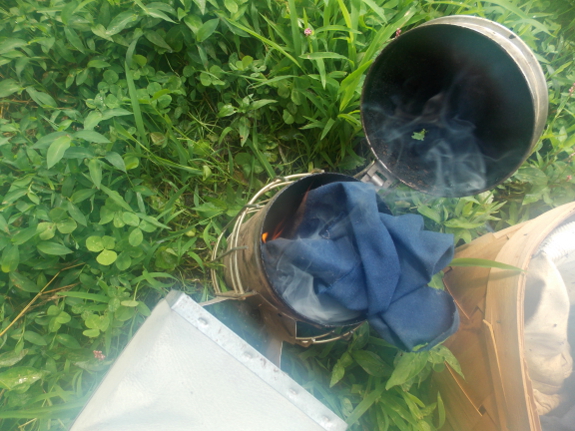
Unfortunately, my
mistake of trying to keep mainstream bees without chemicals killed
off three of the hives the following winter. I split the
remaining hive in 2011, which meant the bees were busy rebuilding
and didn't have time to make extra honey for their
beekeeper. And then both of those hives died, so last year I
started a new package again (this time of bees that had been
raised chemical-free). But I'd also changed over to Warre
beekeeping methods, so I allowed those bees to swarm...which
slowed them down yet again.
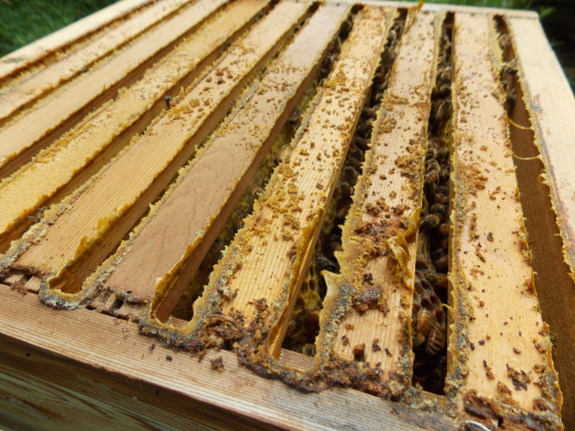
Which is all a long
way of explaining why I'm still making basic beginner mistakes in
the honey harvest department. I had decided to take
a box of honey off our busiest hive, but when I removed the
roof, even after smoking, there seemed to be a lot more bees buzzing around
than I thought there should have been. This was my clue to
pull up a frame and make sure the box was full of honey only, but
I blithely took off the box without checking, shut the hive back
up, and carried my haul halfway back to the trailer.
There, I finally
pried up a frame. The first two frames were full of pollen
and honey, and I set them aside. But the third frame was
covered with capped brood, and so was the fourth! Uh
oh. No wonder the bees were pissed off, buzzing me despite
having been smoked and carried away from home base.
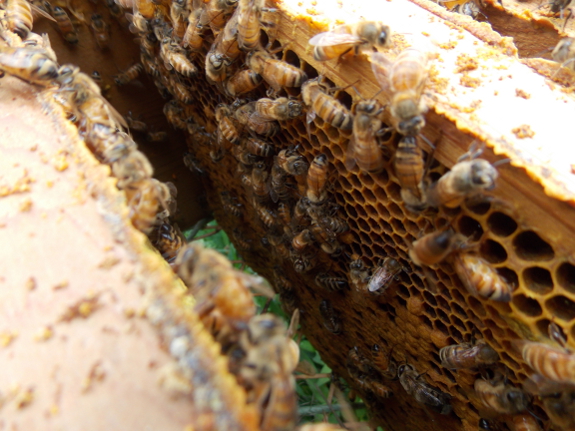
Even though this all
makes sense as I write it, you have to pretend you're me, alone on
the farm (Mark was at the post office) with bees everywhere and
very little memory of what you did last time you harvested
honey. I probably should have just put everything back, shut
the hive up, and dealt with it later once the bees calmed
down. But instead I figured I would first take one of those
empty boxes from the less-strong Warre hive so the first hive
could maintain their building streak.
The trouble is, I smelled like angry bees, so when I went over to
the other hive, they quickly got riled up, and then got angrier
when I could barely lift the hive off the empty box on the
bottom. As I struggled to put the occupied boxes back in
place, guard bees came streaming out of the hive and one stung me
on each knee. In a perfect world, I could have stepped back
after the first sting, but I had to get the hive back on its base
so it wouldn't tip over, and by the time that happened, a dozen
bees had latched onto each knee, and many were managing to sting
straight through my jeans.
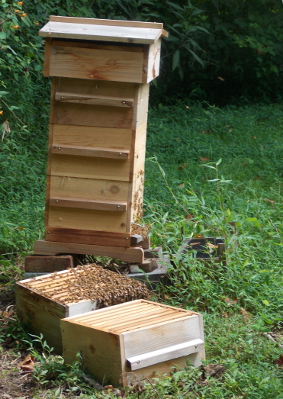 So I ran back to the
trailer, batting at my legs, then rushed through room after room,
brushing off bees in each space and shutting the door so the angry
insects couldn't follow me. Out the other door to brush off
more bees on the porch, then back into the trailer to brush off
the last few bees and pull on another pair of pants and our spare
bee suit to mask the alarm smell.
So I ran back to the
trailer, batting at my legs, then rushed through room after room,
brushing off bees in each space and shutting the door so the angry
insects couldn't follow me. Out the other door to brush off
more bees on the porch, then back into the trailer to brush off
the last few bees and pull on another pair of pants and our spare
bee suit to mask the alarm smell.
Too worn out (and
bee-shy) to do much work on the busy hive I'd begun with, I simply
took off the top and quilt, plopped on the empty box and then the
box of brood, closed the hive back up, and returned to the house
to crush the two frames of honey I'd taken out of that box before
realizing it was full of brood.
I'm not sure why the
top box of our busiest hive was full of brood --- bees are
supposed to start work at the top and move down into the new boxes
I'd put underneath. But nature doesn't always work the way
books tell you it does, and the top box was definitely chock full
of brood. Since the hive is now too heavy to lift up,
allowing me to nadir new boxes underneath, I'll just keep adding
empties to the top if the bees continue to need the space.
Come spring, the colony will be smaller, the bees will have moved
out of most of the boxes, and any honey left should be much easier
to harvest. Maybe by then I'll be able to harvest honey
without making stupid mistakes and getting stung.
Want more in-depth information? Browse through our books.
Or explore more posts by date or by subject.
About us: Anna Hess and Mark Hamilton spent over a decade living self-sufficiently in the mountains of Virginia before moving north to start over from scratch in the foothills of Ohio. They've experimented with permaculture, no-till gardening, trailersteading, home-based microbusinesses and much more, writing about their adventures in both blogs and books.
Want to be notified when new comments are posted on this page? Click on the RSS button after you add a comment to subscribe to the comment feed, or simply check the box beside "email replies to me" while writing your comment.

Ouch! That is hard getting stung and chased by angry bees! Have you tried a Warre forklift? I'm sure Mark could whip one up for you in a jiffy.
Even better- lots of links, pictures, and plans: http://warre.biobees.com/lift.htm